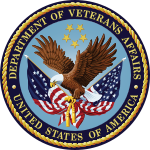The United States Department of Veterans Affairs (VA) is a Cabinet-level executive branch department of the federal government charged with providing life-long healthcare services to eligible military veterans at the 170 VA medical centers and outpatient clinics located throughout the country. Non-healthcare benefits include disability compensation, vocational rehabilitation, education assistance, home loans, and life insurance. The VA also provides burial and memorial benefits to eligible veterans and family members at 135 national cemeteries.
While veterans' benefits have been provided by the federal government since the American Revolutionary War, a veteran-specific federal agency was not established until 1930, as the Veterans Administration. In 1982, its mission was extended to a fourth mission to provide care to non-veterans and civilians in case of national emergencies. In 1989, the Veterans Administration became a cabinet-level Department of Veterans Affairs. The agency is led by the Secretary of Veterans Affairs, who, being a cabinet member, is appointed by the President.
As of June 2020, the VA employs 412,892 people at hundreds of Veterans Affairs medical facilities, clinics, benefits offices, and cemeteries. In Fiscal Year 2016 net program costs for the department were $273 billion, which includes the VBA Actuarial Cost of $106.5 billion for compensation benefits. The long-term "actuarial accrued liability" (total estimated future payments for veterans and their family members) is $2.491 trillion for compensation benefits; $59.6 billion for education benefits; and $4.6 billion for burial benefits.









